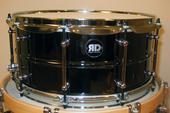 After my recent post about doctoring your snare sound in the studio, I feel obligated to mention something about the more important factor in studio snare sound: deciding WHEN to use a doctored sound. Like I said before, the snare tone is a crucial element in the overall feel and vibe of a track, so you don’t want to use a strange muffling technique just for the fun of it. The snare sound you choose needs to fit the song.
After my recent post about doctoring your snare sound in the studio, I feel obligated to mention something about the more important factor in studio snare sound: deciding WHEN to use a doctored sound. Like I said before, the snare tone is a crucial element in the overall feel and vibe of a track, so you don’t want to use a strange muffling technique just for the fun of it. The snare sound you choose needs to fit the song.
The main issue is context. In fact, this is true for music generally, not just studio snare tone. Context is king. A fill is not “cool” on it’s own… it is only cool when it fits well in the moment that you play it. Consequently, a fill that you hear on a record might be really cool in the song where you heard it, and not so cool in your own band’s song (especially if your song is a significantly different musical environment). The same is true of snare tone – the “coolness” of a snare sound is directly related to the context of the track you are playing.
So, how does a drummer develop a knack for picking the right snare tone for the studio? In my opinion, musical skills like this are always gained through listening. How often do you make a mental note on the kind of snare tone your favorite drummer is using on a given track? More importantly, how often do you pay attention to the characteristics of the rest of the song and how they might have impacted the decision to use a given snare tone? This kind of awareness in your listening will jump-start your ear for snare sound and context in a big way.
A good record to listen to along these lines would be John Mayer’s “Continuum.” Steve Jordan produced the album and played drums on the whole thing. The first 5 tracks all have noticeably different snare sounds, and they fit so well with the songs.

1 comment
Comments feed for this article
May 25, 2008 at 7:20 pm
ANTHONY GRAVLEY
heya steve !
great to stumble across your page. i look forward to reading through your blogs. i just entered the world of blogging myself. nothing too in depth on there yet… but i plan to dive in deeper this summer.
have an awesome week man.
peace and blessings.
anthony
http://www.anthonygravley.com
http://www.myspace.com/anthonygravley